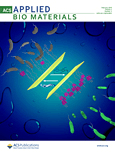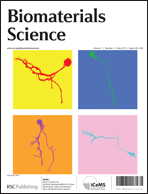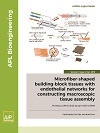
ACS Applied Bio Materials
Scope & Guideline
Innovating the Future of Bioengineering and Materials Science
Introduction
Aims and Scopes
- Biomaterials for Drug Delivery:
Research focusing on the design and optimization of biomaterials that can effectively deliver therapeutic agents, enhancing the bioavailability and targeting of drugs. - Tissue Engineering and Regenerative Medicine:
Investigation of biomaterials that support cell growth, differentiation, and tissue regeneration, aiming to develop solutions for repairing or replacing damaged tissues. - Nanotechnology in Biomedical Applications:
Utilization of nanoscale materials and structures to improve drug delivery, imaging, and therapeutic efficacy in various medical conditions. - Biosensors and Diagnostics:
Development of biomaterials for creating advanced biosensors that enable the detection of biological markers for disease diagnosis and monitoring. - Antimicrobial and Antibiofilm Strategies:
Exploration of materials designed to combat infections, particularly those associated with medical devices and implants, through antimicrobial properties and biofilm prevention. - Smart and Responsive Biomaterials:
Creation of materials that can respond to environmental stimuli (e.g., pH, temperature) for controlled release of drugs or other bioactive agents.
Trending and Emerging
- Targeted and Personalized Medicine:
The development of biomaterials tailored for specific patient populations or disease mechanisms is gaining traction, enhancing the efficacy of treatments. - Integration of Artificial Intelligence and Machine Learning:
The application of AI and machine learning in the design and optimization of biomaterials is emerging, facilitating predictive modeling and personalized approaches. - Sustainable and Biodegradable Materials:
There is a growing focus on creating eco-friendly biomaterials that reduce environmental impact while maintaining functionality in medical applications. - Micro- and Nano-Scale Fabrication Techniques:
Advancements in fabrication techniques, including 3D printing and electrospinning, are enabling the creation of complex and functional biomaterials with enhanced properties. - Hybrid and Composite Materials:
Research is increasingly centered on developing hybrid materials that combine the beneficial properties of different components to improve performance in biomedical applications. - Immunomodulatory Biomaterials:
Materials designed to actively modulate immune responses are emerging, particularly in the context of cancer therapy and regenerative medicine.
Declining or Waning
- Conventional Materials for Drug Delivery:
There has been a noticeable shift away from traditional polymer-based drug delivery systems towards more advanced and multifunctional nanocarrier systems. - Single-Use Medical Devices:
Research focusing solely on single-use devices is decreasing as there is a growing emphasis on sustainability and the development of reusable or biodegradable materials. - Basic Biocompatibility Studies:
The focus on basic biocompatibility assessments is waning as more comprehensive studies encompassing complex biological interactions are increasingly prioritized. - Passive Antimicrobial Coatings:
The interest in passive coatings that merely inhibit microbial growth is declining in favor of more active and responsive antimicrobial strategies. - Traditional Tissue Engineering Approaches:
Classic approaches in tissue engineering are being overshadowed by innovative strategies that integrate stem cells, bioactive factors, and smart materials.
Similar Journals

Biomaterials Science
Connecting science and application in the realm of biomaterials.Biomaterials Science is a premier journal published by the Royal Society of Chemistry that serves as a leading platform for researchers and professionals in the fields of Biomedical Engineering and Materials Science. With an impressive impact factor bolstered by its Q1 quartile ranking in both disciplines, this journal has positioned itself at the forefront of cutting-edge research, showcasing innovative materials and applications that drive advancements in healthcare and technology. Since its inception in 2013, Biomaterials Science has been committed to disseminating high-quality, peer-reviewed articles that promote scientific knowledge and collaboration among academia and industry. With a global readership and a focus on open access, researchers are encouraged to share their findings to facilitate the development of transformative biomaterials and their applications. Join a vibrant community of scholars as we explore the future of biomaterials through this esteemed publication, enhancing both scientific inquiry and practical application.

Biomedical Materials
Bridging Biology and Engineering for Medical Breakthroughs.Biomedical Materials, published by IOP Publishing Ltd, is a premier journal dedicated to the rapidly evolving field of biomedical engineering and materials science. With a robust impact factor showcasing its influence, this journal serves as a vital platform for disseminating pioneering research from 2006 to 2024. Covering an array of interdisciplinary topics—ranging from biomaterials to bioengineering and applied chemistry—the journal consistently ranks in the second quartile across multiple categories including Bioengineering (Q2), Biomaterials (Q2), and Biomedical Engineering (Q2) as of 2023. Researchers, professionals, and students alike benefit from its contributions, exploring innovative solutions at the intersection of biology and material science. Although not an Open Access journal, Biomedical Materials remains essential in advancing our understanding and facilitating discussions surrounding state-of-the-art materials that revolutionize medical applications and enhance patient care.

Materials Science & Engineering C-Materials for Biological Applications
Pioneering new frontiers in biomaterials research.Materials Science & Engineering C-Materials for Biological Applications is a premier journal published by ELSEVIER, dedicated to advancing the field of biomaterials through interdisciplinary research. With a robust ISSN of 0928-4931, this journal has made its mark in the realms of Chemical Engineering and Materials Science, achieving impressive Scopus rankings within its categories, namely Rank #16/151 in Bioengineering (89th percentile) and Rank #13/112 in Biomaterials (88th percentile). Although the journal's coverage in Scopus has been discontinued since 2021, it remains a critical resource for researchers, professionals, and students eager to explore innovative materials and their applications in biological contexts. The journal’s open access policy enhances its accessibility, fostering a global exchange of knowledge and inspiring future advancements in the field of materials science.

APL Bioengineering
Innovating at the Intersection of Science and MedicineAPL Bioengineering is a premier open-access journal published by AIP Publishing, dedicated to advancing the field of bioengineering and its interdisciplinary applications. Established in 2017, this journal serves as a vital platform for researchers, professionals, and students interested in the critical intersections of bioengineering, biomaterials, biomedical engineering, and biophysics. With an impressive impact factor and consistent rankings in the Q1 category across multiple domains, including biochemistry and materials science, APL Bioengineering has positioned itself among the top journals in its field. The journal aims to publish innovative original research, comprehensive reviews, and insightful case studies that further the understanding and application of bioengineering principles. Since its inception, APL Bioengineering has fostered a community of thought leaders, providing open access to ensure broad dissemination of knowledge and advancements that underpin the future of biomedical innovation.

Nanotechnology Science and Applications
Elevating Knowledge in Nanotechnology and Pharmaceutical Sciences.Nanotechnology Science and Applications, published by DOVE MEDICAL PRESS LTD, is a premier open-access journal dedicated to advancing knowledge in the fields of nanoscience and nanotechnology, particularly focusing on their applications in bioengineering, biomedical engineering, and pharmaceutical sciences. Since its inception in 2008, this journal has provided a platform for the dissemination of high-quality research that is rigorously peer-reviewed, ensuring that only the most impactful findings reach a global audience. With an impressive impact factor reflected in its recent categorization in the Q1 tier for Pharmaceutical Science and Q2 for Bioengineering and Nanoscience, it stands as a critical resource for researchers, practitioners, and students eager to explore the cutting-edge innovations within these rapidly evolving disciplines. The journal's commitment to accessibility and its robust indexing in Scopus—ranked highly in its respective categories—reinforces its importance as a leading forum for the exchange of scientific knowledge and the fostering of collaborative research in nanotechnology applications.

Current Opinion in Biomedical Engineering
Connecting experts for innovative biomedical solutions.Current Opinion in Biomedical Engineering is a renowned journal published by Elsevier, focusing on the cutting-edge developments and critical assessments in the fields of biomedical engineering and related disciplines. With an ISSN of 2468-4511, it provides a valuable platform for researchers and professionals to disseminate their insights and discoveries in areas such as bioengineering, biomaterials, and medicine. Its impressive impact factor positions it in the Q2 category for several fields, including Bioengineering and Biomedical Engineering, highlighting its influence and relevance in ongoing scientific dialogues. The journal’s unique format of opinion pieces and reviews encourages innovative thinking and fosters collaboration among experts. As an essential resource for those engaged in the life sciences and engineering, Current Opinion in Biomedical Engineering serves to stimulate discussion, promote knowledge exchange, and drive advancements in biomedical applications. Set in the Netherlands at Radarweg 29, 1043 NX Amsterdam, the journal is accessible through various academic platforms, enabling a global readership to engage with the latest scholarly work in this dynamic field.

JOURNAL OF BIOMEDICAL MATERIALS RESEARCH PART A
Innovating the intersection of materials science and medicine.JOURNAL OF BIOMEDICAL MATERIALS RESEARCH PART A, published by WILEY, is a leading journal in the field of biomaterials and biomedical engineering, showcasing cutting-edge research that bridges the gap between material science and healthcare applications. With a robust 2023 impact factor reflecting its high-quality contributions, this journal is classified in the Q2 quartile for Biomaterials, Biomedical Engineering, and Ceramics and Composites, while achieving an impressive Q1 ranking in Metals and Alloys. The journal caters to a diverse readership, including researchers, professionals, and students, aiming to facilitate innovation and advancements in biocompatible materials and their applications in medical devices and tissue engineering. Access options for readers are available, ensuring the latest studies and findings are readily accessible to all stakeholders in this dynamic field. As it progresses towards its 2024 target, the JOURNAL OF BIOMEDICAL MATERIALS RESEARCH PART A continues to be an essential resource for anyone involved in the development and application of biomedical materials.

Materials Today Bio
Unlocking innovative solutions at the intersection of materials and biology.Materials Today Bio, published by Elsevier, is an esteemed open-access journal dedicated to advancing the fields of bioengineering, biomaterials, and biomedical engineering. Since its inception in 2019, this journal has quickly made a name for itself, currently ranked Q1 in multiple categories including Bioengineering, Biomaterials, and Biotechnology, reflecting its exceptional quality and relevance in the rapidly evolving landscape of bio-related sciences. With an impressive Scopus ranking positioning it in the top 25% of its categories, Materials Today Bio provides a vital platform for researchers and professionals to share cutting-edge discoveries and innovative applications that bridge the gap between materials science and biological studies. Accessible to a global audience, this journal not only fosters collaboration among the scientific community but also aims to highlight significant advancements in cell and molecular biology, making it an indispensable resource for students and seasoned experts alike. The journal's commitment to open access since 2019 underscores its dedication to disseminating knowledge widely, ensuring that crucial findings reach those who can benefit from them the most.

Acta Biomaterialia
Advancing the Frontiers of Biomaterials ResearchActa Biomaterialia, published by Elsevier Science Ltd, is a leading journal in the fields of biochemistry, biomaterials, biomedical engineering, biotechnology, and molecular biology. With an ISSN of 1742-7061 and an E-ISSN of 1878-7568, this prestigious journal has secured a remarkable position in the academic community, evidenced by its inclusion in the Q1 category across multiple disciplines for 2023. It ranks impressively at #21 in biochemistry, #16 in biomedical engineering, #18 in biotechnology, and #11 in biomaterials, reflecting its high impact and relevance to ongoing research and development. The journal provides a platform for disseminating innovative research and advancements in the design and application of biomaterials, contributing to scientific discussions that propel the field forward. Although it does not currently offer open access options, Acta Biomaterialia continues to attract contributions that advance our understanding of biomaterials and their interactions with biological systems, ensuring that researchers, professionals, and students remain informed about the latest trends and breakthroughs in this rapidly evolving area of study.

JOURNAL OF MATERIALS SCIENCE-MATERIALS IN MEDICINE
Shaping Medical Technologies with Advanced Materials ResearchJOURNAL OF MATERIALS SCIENCE-MATERIALS IN MEDICINE is a leading peer-reviewed journal published by Springer, dedicated to advancing the field of biomedical materials science. With an ISSN of 0957-4530 and E-ISSN 1573-4838, this Open Access journal has been committed to providing researchers and professionals with freely accessible, high-quality research since 2021. It features an extensive scope spanning bioengineering, biomaterials, biomedical engineering, and biophysics, reflecting its significant impact within these interdisciplinary domains. Recognized within the Q2 category of the 2023 rankings in multiple fields, the journal proudly positions itself as a crucial resource for innovative materials that contribute to advancements in medical applications. With impressive Scopus rankings, including 26th in Biophysics and 40th in Materials Science for Biomaterials, researchers, students, and industry professionals alike can rely on this publication for cutting-edge insights that drive the future of medical materials and technologies. Based in Dordrecht, Netherlands, the journal provides a vibrant platform for sharing groundbreaking discoveries and fostering collaborative research among a global audience.